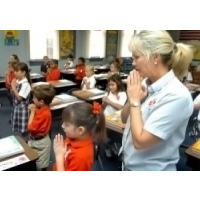Our state legislatures may lack the courage and convictions of what their purpose is - - NULLIFICATION, but teachers and parents are the Christian soldiers marching on as before! Separation of School and State is called for.
By Noel Brinkerhoff | AllGov | June 21, 2013
 Half a century after the U.S. Supreme Court banned prayer in public classrooms, religion is nonetheless very present in schools these days.
Half a century after the U.S. Supreme Court banned prayer in public classrooms, religion is nonetheless very present in schools these days.
In two landmark decisions (Engel v. Vitale and Abington School District v. Schempp), the Supreme Court in 1962 and 1963 declared school-sponsored prayer and Bible readings unconstitutional.
But the rulings applied only to public school teachers and administrators.
Students were free to say grace in the cafeteria, meet outside class to study the Bible, Quran, or Torah, and participate in religious after-school programs on their campuses.
“We’ve gone from virtual silence about religion in the curriculum and virtually no student religious expression in many schools,” Charles Haynes, a scholar at the First Amendment Center and head of the Religious Freedom Education Project in Washington, DC, told the Christian Science Monitor, “to today, when social studies and other standards are fairly generous to religion, and students are expressing their faiths in many different ways in many public schools, if not most.”
Consider the following facts:
Good News Clubs, organized by the Child Evangelism Fellowship, hold Sunday school-like classes in some 3,200 public elementary schools for 156,000 students.
One million to two million students participate in “See You at the Pole” prayer services every September beneath their campus flagpoles.
The Fellowship of Christian Athletes has more than 8,000 chapters on junior and high school campuses across the country.
Campus Crusade for Christ has about 200 clubs, almost all of them in public schools.
Youth for Christ, an evangelical missionary organization, has on- and off-campus clubs at 1,200 schools, most of them public.
Meanwhile, a poll conducted in 2012 by the National Opinion Research Center showed that 57% of Americans disapprove of the Supreme Court prohibition against public schools requiring the reading of Bible verses or the Lord’s Prayer, while 39% approve. However, there were sharp regional differences. A majority in the Northeast and the West did approve of the prohibition, while in the South 73% disapproved. In addition, Americans age 18-29 differed from their elders, approving of the prohibition 56% to 38%.
To Learn More:
Source
By Noel Brinkerhoff | AllGov | June 21, 2013
 Half a century after the U.S. Supreme Court banned prayer in public classrooms, religion is nonetheless very present in schools these days.
Half a century after the U.S. Supreme Court banned prayer in public classrooms, religion is nonetheless very present in schools these days.In two landmark decisions (Engel v. Vitale and Abington School District v. Schempp), the Supreme Court in 1962 and 1963 declared school-sponsored prayer and Bible readings unconstitutional.
But the rulings applied only to public school teachers and administrators.
Students were free to say grace in the cafeteria, meet outside class to study the Bible, Quran, or Torah, and participate in religious after-school programs on their campuses.
“We’ve gone from virtual silence about religion in the curriculum and virtually no student religious expression in many schools,” Charles Haynes, a scholar at the First Amendment Center and head of the Religious Freedom Education Project in Washington, DC, told the Christian Science Monitor, “to today, when social studies and other standards are fairly generous to religion, and students are expressing their faiths in many different ways in many public schools, if not most.”
Consider the following facts:
Good News Clubs, organized by the Child Evangelism Fellowship, hold Sunday school-like classes in some 3,200 public elementary schools for 156,000 students.
One million to two million students participate in “See You at the Pole” prayer services every September beneath their campus flagpoles.
The Fellowship of Christian Athletes has more than 8,000 chapters on junior and high school campuses across the country.
Campus Crusade for Christ has about 200 clubs, almost all of them in public schools.
Youth for Christ, an evangelical missionary organization, has on- and off-campus clubs at 1,200 schools, most of them public.
Meanwhile, a poll conducted in 2012 by the National Opinion Research Center showed that 57% of Americans disapprove of the Supreme Court prohibition against public schools requiring the reading of Bible verses or the Lord’s Prayer, while 39% approve. However, there were sharp regional differences. A majority in the Northeast and the West did approve of the prohibition, while in the South 73% disapproved. In addition, Americans age 18-29 differed from their elders, approving of the prohibition 56% to 38%.
To Learn More:
School Prayer: 50 Years after the Ban, God and Faith more Present than Ever (by Lee Lawrence, Christian Science Monitor)
School Prayer 50 Years Later: What Do Americans Believe? (by Jaweed Kaleem, Huffington Post)
High School Valedictorian Sues to Stop Graduation Prayer (by Noel Brinkerhoff, AllGov)
Related articles
- Prayer in School: Why Isn’t Silent Prayer Good Enough? (atheistrev.com)
- Prayer in School: All Eyes on Mississippi (atheistrev.com)
Source